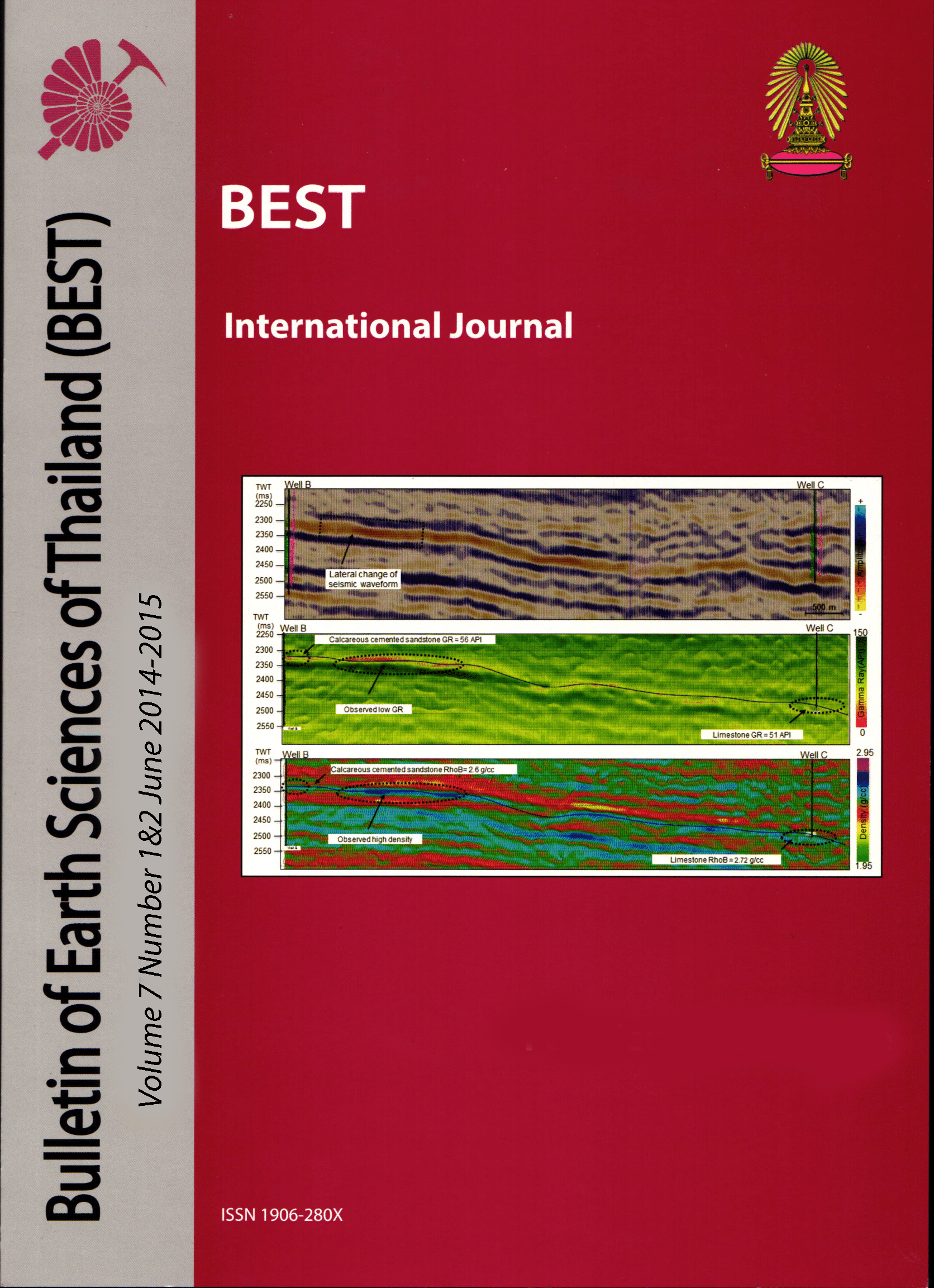Lithology Prediction Using Rock Physics and Acoustic Impedance for Reservoir Distribution in Northern Pattani Basin, Gulf of Thailand
Main Article Content
Abstract
The study area lies in the northern part of the Pattani Basin, Gulf of Thailand. The reservoirs in the basin are fluvial sands. The reservoir sands are compartmentalized and show rapid lateral stratigraphic changes due to their fluvial depositional environment. Imaging of these reservoir sands is not easy by using conventional seismic data. Rock physics analysis and post-stack seismic inversion techniques were applied to map these reservoir sands. According to rock physics analysis, sands and shales have a significant contrast of P-impedance within the stratigraphic interval of Early and Middle Miocene. This contrast decreases in the Oligocene interval, and it is not easy to isolate sands based on P-impedance. Therefore, P-impedance can only discriminate sands in the upper sequences. P-velocity of clean sand and pure shale shows very small or no contrast, but density is different for these lithologies. P-velocity of shale reduces dramatically in a lacustrine section of Oligocene and locally shales have lower P-velocity than sands. Consequently, P-impedance contrast also reduces and makes it difficult to differentiate sand and shale based on P-impedance. The inversion results gave a reasonable match with P-impedance logs at well locations, and blind test results show a good match between actual and predicted P-impedance. Sand bodies were extracted by using computed thresholds of P-impedance based on rock physics cross-plots. Two types of channel belts were observed; 1) high sinuosity and narrow belts within Early Miocene and 2) large and broad channel belts in Middle Miocene. The present study concludes that post-stack P-impedance inversion can successfully map sand reservoirs and determine their connectivity.
Article Details

This work is licensed under a Creative Commons Attribution-NonCommercial-NoDerivatives 4.0 International License.
Copyright © 2008 Department of Geology, Faculty of Science, Chulalongkorn University. Parts of an article can be photocopied or reproduced without prior written permission from the author(s), but due acknowledgments should be stated or cited accordingly.
References
Cooke, D. A. and Schneider, W.A., 1983, Generalized linear inversion of reflection seismic data: Geophysics, v. 48, p. 665-676.
Jardine, E., 1997, Dual Petroleum Systems Governing The Prolific Pattani Basin Offshore Thailand: Proceedings of the Petroleum Systems of SE Asia and Australasia Conference, May 1997, p. 351-363.
Li Y, Guo ZQ, Liu C, et al., 2015, A rock physics model for the characterization of organic-rich shale from elastic properties, Petroleum Science, v. 12, issue 2, p. 264-272.
Meyer, B.L., and Nederlof, M.H., 1984, Identification of Source Rocks on Wireline Logs by Density/Resistivity and Sonic Transit Time/Resistivity Crossplots: The American Association of Petrleum Geologist Bulletim, v.68, no.2, p. 121-129.
Morley, C.K., and Racey, A., 2011, Tertiary stratigraphy, in M.F. Ridd, A.J. Barber, and M.J. Crow, eds., The geology of Thailand: Geological Society of London, p. 223-271.
Morley, C.K., Charusiri, P., Watkinson I.M., 2011, Structural geology of Thailand during the Cenozoic, in M.F. Ridd, A.J. Barber, and M.J. Crow, eds., The geology of Thailand: Geological Society of London, p. 273-334.
Pendrel, J.V., 2001, Seismic inversion-the best tool for reservoir characterization: Canadian Society of Exploration Geophysicists Recorder, v. 26, p. 16-23.
Racey, A., 2011, Petroleum geology, in M.F. Rid, A.J. Barber, and M.J. Crow, eds., The geology of Thailand: Geological Society of London, p. 351-392.
Russell, B. and Hampson, D., 1991, Comparison of Post-stack Seismic Inversion Methods, SEG Expanded Abstracts, 10, 876-878.


